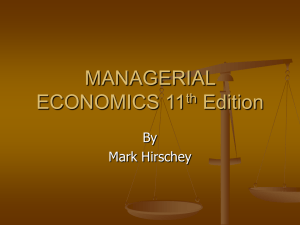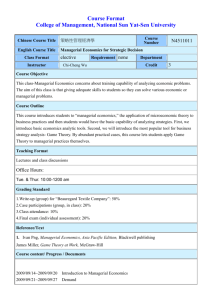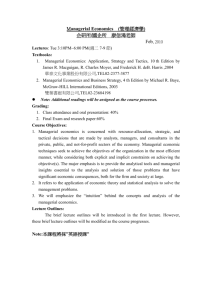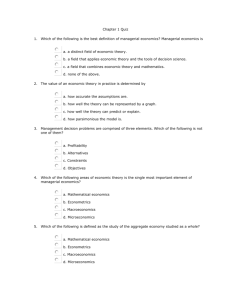MANAGERIAL ECONOMICS 11th Edition
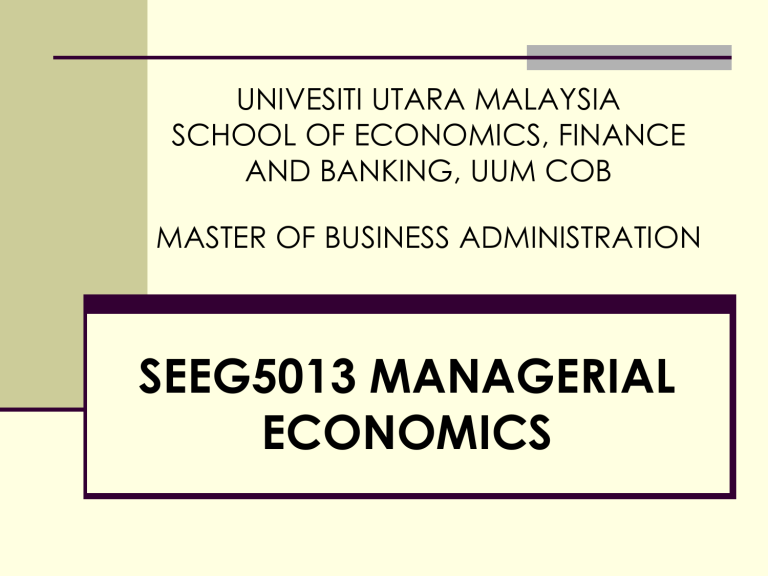
UNIVESITI UTARA MALAYSIA
SCHOOL OF ECONOMICS, FINANCE
AND BANKING, UUM COB
MASTER OF BUSINESS ADMINISTRATION
SEEG5013 MANAGERIAL
ECONOMICS
Chapter 1
Introduction & Goals of the Firm
What is Managerial Economics?
The Decision-Making Model and the
Responsibilities of Management
The Role of Profits?
The Principal-Agent Problem
Shareholder Wealth Maximization and the Real Option Value
Objectives in the Public Sector and
Not-for-Profit Organizations
What is Managerial Economics?
The application of microeconomics to problems faced by decision makers in the private, public, and not-for-profit sectors.
Even questions of how best to abate nitrous oxide by coal-fired Power Plants involves economic issues of finding efficient, least cost solutions.
Managerial economics deals with microeconomic reasoning on real world problems such as pricing decisions, selecting the best strategy in different competitive environments, and making efficient choices.
Responsibility of Management
Managers solve problems before they become a crisis
Managers select strategies to try to assure the success of the firm
Managers create an organizational culture attune to the mission of the organization
Senior management establish a vision for the firm
Managers motivate and promote teamwork
Managers promote the profitability of the firm
And many managers see it in their long-run interest to promote sustainability of their enterprise in their environment.
Managers who fail at these responsibilities are reviled, be they be mangers of BP, Enron, or Bernie Madoff
To Expand Capacity or Not?
An example of a simplified decision problem
Should Honda or Toyota expand its capacity in North
America? In part, it must consider current and future demand and what other firms are likely to do.
Capacity for making cars is a long term project, so these firms should think in terms of the present value (PV) of future profits.
Objective Function :
Max PV of profits {S1(New), S2(Used)}
where S1(New) is expand capacity with new facilities and
S2(Used) to purchase used facilities from GM.
Decision Rule:
Choose S1 if PV {Profits of S1 } > PV { Profits of S2 }
Choose S2 if PV { Profits of S1 } < PV { Profits of S2 }
If equal profits, then flip a coin
If negative profits for both, then don’t expand at all
The Role of Profits?
Economic Profit is the difference between total revenues and total economic cost
(Economic cost includes the “normal” rate of return on capital contributions by the firm’s partners).
We’d expect high profit areas to attract investment
We’d expect low profit areas to lose investment
Shouldn’t then all industries earn the same profit eventually?
Theories of Why Profit Varies
Across Industries
3.
4.
5.
1.
2.
RISK-BEARING Theory of Profit
TEMPORARY DISQUILIBRIUM Theory of Profit
MONOPOLY Theory of Profit
INNOVATION Theory of Profit
MANAGERIAL EFFICIENCY Theory of
Profit
What is Managerial Economics?
Douglas - “Managerial economics is .. the application of economic principles and methodologies to the decision-making process within the firm or organization.”
Pappas & Hirschey - “Managerial economics applies economic theory and methods to business and administrative decision-making.”
Salvatore - “Managerial economics refers to the application of economic theory and the tools of analysis of decision science to examine how an organisation can achieve its objectives most effectively.”
9
What is Managerial Economics?
Howard Davies and Pun-Lee Lam -
“It is the application of economic analysis to business problems; it has its origin in theoretical microeconomics.”
10
Managerial Economics Defined
The application of economic theory (eg. demand theory, production theory, cost theory, market structure) and the tools of decision science (eg. mathematics and regression analysis) to examine how an organization can achieve its aims or objectives most efficiently.
How Is Managerial Economics Useful?
Evaluating Choice Alternatives
Identify ways to efficiently achieve goals.
Specify pricing and production strategies.
Provide production and marketing rules to help maximize net profits.
Making the Best Decision
Managerial economics can be used to efficiently meet management objectives.
Managerial economics can be used to understand logic of company, consumer, and government decisions.
ECONOMIC ANALYSIS AND
DECISIONS
1. Demand Analysis
2. Production and Cost Analysis
Product, Pricing, and Output
Decisions
4. Capital Expenditure Analysis
ECONOMIC, POLITICAL, AND SOCIAL
ENVIRONMENT
1. Business Conditions (Trends, Cycles, and
Seasonal Effects)
2. Factor Market Conditions (Capital, Labour, and Raw Materials)
3. Competitors’ Reactions and Tactical
Response
4. Orgabization architecture and Regulatory
Cash Flows
Firm Value
(Shareholders’ Wealth)
Risk
Evaluating Choice Alternatives
Managerial Economics identifies ways to efficiently achieve goals. For example,
To identify pricing and production strategies to help small business meet short run objective such as rapid growth.
Provides production and marketing rules that permit the company to maximize net profits once it has achieve growth or market share objectives.
Evaluating Choice Alternatives
Managerial economics has applications in both profit and not-for-profit sectors
For example, an administrator of a nonprofit hospital strives to provide the best medical care possible given limited staff, equipment, and related resources. Using the tools and concepts of managerial economics, the administrator can determine the optimal allocation of these limited resources.
Making the best decision
To make a good decision, managers must understand the economic environment in which they operate. For example,
A grocery retailer may offer consumers a highly price-sensitive product, such as rice, at an extremely low markup over cost – say, 1 percent to 2 percent – while offering less price-sensitive products, such nonprescription drugs, at markups of as high as 40 percent over cost. (Discuss : HYPERMARKET VS SUPERMARKET; MAS
VS AIR ASIA; PASARAYA PELADANG VS PACIFIC etc.)
Similarly, managerial economics reveals that car import quotas reduce the availability of substitutes for domestically produced cars, and create the possibility of monopoly profits for domestic manufacturers.
It does not explain whether imposing quotas is good public policy
(benefits for consumers, lower income group, environment etc.); that is a decision involving broader political considerations. Managerial economics only describes the predictable economic consequences of such actions. (draw diagram govt. intervention - QUOTAS; impact of changes in EXCHANGE RATE).
Theory of the Firm
Expected Value Maximization
Owner-managers maximize short-run profits.
Primary goal is long-term expected value maximization.
Constraints and the Theory of the Firm
Resource constraints.
Social constraints
Limitations of the Theory of the Firm
Alternative theory adds perspective.
Competition forces efficiency.
Hostile takeovers threaten inefficient managers.
The firm connect suppliers, investors, workers, and management in a joint effort to serve customers.
Value of the Firm
The value of the firm is the present value of the firm’s expected future net cash flows.
If cash flows are equated to profits for simplicity, the value of the firm today, or its present value, is the value of expected profits
, discounted back to the present at an appropriate interest rate. (?? Why we have to do discounting?).
Value of the Firm
The present value of all expected future profits
PV
(1
1
r
)
1
(1
2
r
t
) n
1
(1
t
r
(1 )
t
n
r
) n t n
1 t
n
TR
1
(1 t
(1
r r
t
TC
) ) t t t
Shareholder Wealth Maximization [1.1]
t
= REVENUE – COST = TR t
– TC t
= P t
Q t
– V t
Q t
- F t
Value of the Firm = the present value of discounted future cash flows, both from current operations but also those that might be.
V
0
∙(shares outstanding) =
1
Value
/(1+k e
) 1 +
2
/(1+k e
) 2 + … + Real Option or
V
0
∙(shares outstanding) =
(
t
) / (1+k e
) t + Real Option Value t=1
The real option value of the firm comes from the flexibility that the firm has to find added cost savings or new revenue possibilities that have not yet come to pass, but could in the future because of following their current business plans.
V
0 is the current value of a share of stock.
Whatever lowers perceived risk of the firm (k e
) will raise firm value.
Whatever raises the profits of the firm, raises firm value
Profit Measurement
Business Versus Economic Profit
Business (accounting) profit reflects explicit costs and revenues.
Economic profit.
Profit above a risk-adjusted normal return.
Considers cash and noncash items.
Variability of Business Profits
Business profits vary widely.
Relationship between profits, total revenues and total costs.
The ‘value of firms’ equation can be used to examine how the expected value maximization model relates to a firm’s various functional department.
The marketing department often has primary responsibility for product promotion and sales (TR);
The production department has primary responsibility for product development costs (TC); and
The finance department has primary responsibility for acquiring capital and, hence, for the discount factor
(r) in the denominator.
Why every department important?
The marketing department can help reduce costs associated with a given level of output by influencing customer order size and timing (TR = p x q).
The production department can stimulate sales by improving quality (discuss ISO and quality control).
Other departments, for example – accounting, human resources, and transportation, provide information that are useful for sales growth (TR) and cost control
(TC).
Constraints and the Theory of the Firm
Managerial decisions are often made in light of constraints imposed by technology, resource scarcity, contractual obligations, and regulations.
Managers often face limitations on the amount of investment funds available for a particular project or activity.
Decisions can also be constrained by contractual requirements. For example, contracts sometimes require that a minimum level of output be produced to meet delivery requirements.
In most situation, output must also meet quality requirements.
Definitions of Profit
Business Profit: Total revenue minus the explicit or accounting costs of production.
Economic Profit: Total revenue minus the explicit and implicit costs of production (i.e. the implicit (non-cash) costs of capital and other owner provided inputs, used by the firm).
Opportunity Cost: Implicit value of a resource in its best alternative use.
Role of Profits in the Economy
Economic profits play an important role in a marketbased economy.
Above-normal profits serve as valuable signal that firm or industry output should be increased.
Entry by new competitors often occurs quickly during high profit periods.
Just as above-normal profits provide a signal for expansion and entry, below-normal profits provide a signal for contraction and exit.
Above-normal profits can also constitute an important reward for innovation and efficiency, just as below-normal profits can serve as a penalty for stagnation and inefficiency.
Function of Profit
Profit is a signal that guides the allocation of society’s resources.
High profits in an industry are a signal that buyers want more of what the industry produces.
Low (or negative) profits in an industry are a signal that buyers want less of what the industry produces.
Why Firms Exist?
Firms exist by public consent to serve social needs.
Maximization of sosial welfare requires answering the following important questions:
What combination of goods and services should be produced?
How to produce?
How to distribute goods and services?
Why Do Profits Vary Among
Firms?
Disequilibrium Profit Theories
Rapid growth in revenues.
Rapid decline in costs.
Compensatory Profit Theories
Better, faster, or cheaper than the competition is profitable.
Role of Business in Society
Why Firms Exist
Business is useful in satisfying consumer wants.
Business contributes to social welfare
Social Responsibility of Business
Serve customers.
Provide employment opportunities.
Obey laws and regulations.
To make good economic decisions, managers need to be able to forecast & estimate relationships
Will be forecasting demand (both P t
& Q t
)
applies to for-profit corporations
non-profit organizations
Hospital Administrators forecast patients
University Administrator forecast enrollment
Regression analysis, time series methods, and qualitative forecasting methods used for forecasting
Agency Problems
Modern corporations allow firm managers to have no ownership participation, or only limited participation in the profitability of the firm.
Shareholders may want profits, but managers may wish to relax.
The shareholders are principals , whereas the managers are agents .
The Principal-Agent Problem
Shareholders (principals) want profit
Managers (agents) want leisure & security
Conflicting motivations between these groups are called agency problems.
Examples
KKR’s takeover of RJR Nabisco to refocus on wealth-maximization
The LBO by O.M. Scott (a lawn fertilizer company) from ITT (a conglomerate) improved
Scott’s performance
Goals in the Public Sector and the
Not-For-Profit (NFP) Enterprise
Public Goods are goods that can be consumed or used by more than one person at the same time with no extra cost
(like a flood control or national defense).
Sometimes governments produce public goods. Other times, they are exclusive to one person (like a free meal).
Instead of profit, NFP organizations may have as their goals:
1.
Maximization of the quantity of output, subject to a breakeven constraint.
2.
Maximization of the utility (happiness) of NFP administrators.
3. Maximization of cash flows.
4. Maximization of the utility of contributors to the NFP organization.
Which goal a NFP manager selects affects decisions made.
A food shelter manager may decide to maximize the utility of contributors by selecting only "healthy foods"
Public sector managers are performance monitored
.
V.A. hospital administrators are rewarded by reducing the cost per bed over a year. Hence, they become efficient with respect to costs.
The "friendliness" of the hospital staff is harder to measure, so friendliness will tend not be a high priority of the public sector manager.
The Changing Environment of
Managerial Economics
Globalization of Economic Activity
Goods and Services
Capital
Technology
Skilled Labor
Technological Change
Telecommunications Advances
The Internet and the World Wide Web
These Definitions Cover a Number of
Different Approaches
1. Analysis based on the theory of the firm
2. Analysis based upon management sciences
3. Analysis based upon industrial economics
Related to, but not the same as management science and industrial economics.
40
The Process of Model-building
The economics ‘method’
‘illicit relationships with beautiful models’
The steps: the hypothetical-deductive approach
make assumptions about behaviour
work out the consequences of those assumptions make predictions test the predictions against the evidence
PREDICTIONS SUPPORTED? The model is accepted as a good explanation (for the moment)
PREDICTIONS REFUTED? Go back and re-work the whole process
41
Definitions
& assumptions
Theoretical analysis
Predictions
Predictions tested against data
If predictions not supported by data, model is amended or discarded
If predictions borne out by data, the model is valid, for the moment
42
Should Assumptions be Realistic?
The assumption of profit-maximising may be unrealistic or inaccurate
However, what matters is the explanatory or predictive power of a theory (or model), not the descriptive realism of its assumptions.
A model built on unrealistic assumptions may give good predictions.
Assumptions are a necessary simplifying device
Example: Overtaking
43
What Is A “Good” Model?
It allows us to make predictions and set hypotheses
The predictions can be tested against the empirical evidence
The predictions are supported by the empirical evidence
44
The Use of Economic Models
Positive Economics:-
Derives useful theories with testable propositions about WHAT IS.
Normative Economics:-
Provides the basis for value judgements on economic outcomes.WHAT SHOULD BE
45
Managerial Economics
Not very concerned about the descriptive realism of assumptions: “I assume X” does not mean “I believe X to be true”
Economics in general takes a ‘positive’ and predictive approach not prescriptive or
‘normative’
trying to explain “what is” not what “should be”
the main objective is to understand how a market economy works
Some real tension if the models are used for prescription
assume “perfect knowledge”: OK for model-building
knowledge”
Economic Analysis
Comparative Statics
begin with an initial equilibrium position - the starting point change something identify the new equilibrium, e.g:in neo-classical model of the firm
When demand increases?
When costs rise?
When a fixed cost increases?
This is the main purpose of the model -what it was designed to do
Normative prescriptions
it will cost me $30 per unit to supply something which will give me
$20 per unit in revenue- should I do it?
I must pay $20 billion to set up in my industry. Should I charge higher prices to get that money back?
Positive and Normative are linked by “if?” IF the aim of the firm is to maximise profit what will it do/what should it do?
47
What is the purpose of economic analysis?
Why do we want to apply economic analysis to business problems?
For the academic economist : to understand, to make predictions about firm’s behavior The “ to theory: What is?
positive ” approach
For the businessperson : “to assist decision-making”, to provide decision-rules which can be applied The
“ normative ” approach to theory: What should be?
These purposes are different, they can lead to misunderstanding, and economists are not always honest about the limitations of their approach for practical purposes.
48
What are these limitations?
If the aim is prediction, unrealistic assumptions are acceptable and may be needed; for instance, the firm may be assumed to behave “as if” its managers had perfect knowledge of its environment
If the aim is to produce decision-rules which can be applied by practising managers, unrealistic assumptions will produce decision-rules which are not operational for instance, set output and price by MC=MR 49
How Can Managerial Economics
Assist Decision-Making?
1. Adopt a general perspective, not a sample of one
2. Simple models provide stepping stone to more complexity and realism
3. Thinking logically has value itself and can expose sloppy thinking
50
Why Managerial Economics?
A powerful “analytical engine”.
A broader perspective on the firm.
what is a firm?
what are the firm’s overall objectives?
what pressures drive the firm towards profit and away from profit
The basis for some of the more rigourous analysis of issues in Marketing and Strategic
Management.
51
Links between Managerial
Economics and Industrial Economics
In managerial economics , the emphasis is upon the firm, the environment in which the firm finds itself, and the decisions which individual firms have to take.
In industrial economics (or industrial organization) , the emphasis is (or was) upon the behavior of the whole industry, in which the firm is simply a component.
52
What is Industrial Organization?
It studies how the performance of an industry is related to its structure, that is, to the number and size of firms it contains.
It is the study of markets for goods and of the firms which produce them. It is the study of industry. It is more concerned with why markets are structured the way they are and behave the way they do.
53
Questions Asked in Industrial
Organization: a
Why are some markets monopoly-like while others are competitive?
a
How can industry performance and structure be measured or analyzed?
a
How does the performance of individual firms affect the structure and performance of the industry in which they operate?
a
If industry performance seems deficient but remediable, which government policies are likely to help more than they cost?
54
The Structure-Conduct-Performance Paradigm:
Basic Conditions : factors which shape the market of the industry, e.g. demand, supply, political factors
Structure : attributes which give definition to the supply-side of the market, e.g. economies of scale, barriers to entry, industry concentration, product differentiation, vertical integration.
Conduct : the behavior of firms in the market, e.g. pricing behavior advertising, innovation.
Performance : a judgement about the results of market behaviour, e.g. efficiency, profitability, fairness/income distribution, economic growth.
How can the government improve the performance in an industry?
55
Basic Conditions
Structure
Conduct
Performance
Government
Policy
56
Links between Managerial Economics and Management Science
Managerial economics: is often concerned with finding optimal solutions to decision problems.However, the primary purpose of using models is to predict how firms will behave, not to advise them what ought to do. Managers are assumed to find the optimal solutions for themselves and that is how predictions are made.
Management science: is essentially concerned with techniques for the improvement of decision-making and hence it is essentially normative;firms are not assumed to find the optimal solutions for themselves. They are found by the researchers who then present them as prescriptions for what the firm should do.
57

